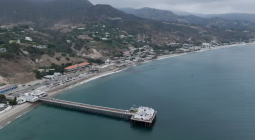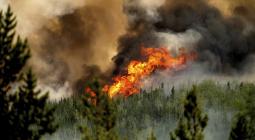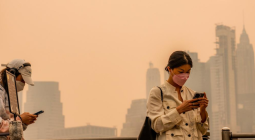Smokey air, nonstop nosebleeds. Life as a warehouse worker in a heatwave: ‘Products matter more than people’
As the Line fire exploded, dense smoke made it difficult to breathe and heat became ‘intolerable’, but work carried on
Uncontrolled wildfires ripped across southern California amid a startling late summer heatwave this month, shrouding the region in thick, dark smoke as temperatures climbed past 110F (43.3C).
But Cynthia Ayala, a ramp agent at one of Amazon’s largest air freight hubs, had to report to work anyway.
Ayala, 28, puts in 10-hour shifts at the air hub, a sprawling facility in San Bernardino, California, 60 miles east (97km) of Los Angeles. The job involves wheeling 7ft-tall, 3,500lb containers of cargo in and out of the hub warehouse, often in sweltering outdoor temperatures.
“I’ve gotten used to the heat,” said Ayala, who’s been on the job for the past three years. On an average workday, Ayala walks about 13,000 steps – equivalent to about 6.5 miles. She has grown accustomed to returning home each evening drenched in sweat, with achy legs.
The dark smoke was something new. “We saw ash falling from the sky,” she said.
During a blistering heatwave, the Line fire exploded across nearly 40,000 acres in the Inland Empire, which has one of the largest concentrations of logistics warehouses in the country. As the fire advanced, thousands of residents, including several of Ayala’s co-workers, were asked to evacuate their homes.
Still, tens of thousands of warehouse workers – forklift operators, packagers, truck drivers and delivery workers – continued working to fulfill consumers’ growing reliance on one-click, doorstep delivery.
Ayala was preparing to drive to work on a Sunday, when a co-worker called to tell her the smoke was so dense at the air hub, they couldn’t breathe. By the time Ayala clocked in, the fire was burning so hot it had created its own thunderstorms. Another co-worker was crying because she was fatigued and it had become painful to breathe.
Several others checked into the site’s healthcare centre and were given the advice to rest before returning outside to work. “And it wasn’t just people who worked outdoors – we could smell smoke inside the building,” Ayala said. “This was just getting intolerable for us.”
That day, a group of about 50 employees approached their management to demand they be sent home, with pay. “Amazon was giving us the runaround, management was giving us the runaround. But ash was falling from the sky and we demanded an answer,” she said.
Eventually, Amazon agreed to shut down operations and sent employees home with pay. It was a major win for workers at the air hub, who have been organizing for better working conditions since the air hub opened in 2021. But the relief was short-lived. Ayala and her co-workers were told to return on Tuesday; those who felt unsafe were given the option to stay home without pay. “But it’s not really a choice, because we need the money,” Ayala said.
Amazon contests this account, stating that they “proactively closed” the air hub for almost 48 hours.
The company did so, “out of an abundance of caution after the Line fire more than doubled in size overnight. The facility remained closed for about two days, and employees were paid during that time,” said Montana MacLachlan, a spokesperson for Amazon.
MacLachlan said that Amazon constantly monitors AQI at its facility in San Bernardino, and brings in extra air scrubbers and provides N95 masks to employees when the air quality deteriorates. “The health and safety of our employees is paramount and we encourage employees to take breaks often as needed, especially those who work in roles exposed to the elements,” she said.
In February, the air hub was cited three times by California Osha for endangering workers in the summer heat, including for using the shadow under a Boeing 767-300 as an area for workers to take their cool-down rests. Amazon contested the citations.
In a region that is increasingly experiencing explosive wildfires and extreme heat, fueled by an escalating climate crisis, workers at logistics facilities and warehouses across the region have been pushing for stronger, statewide heat-safety measures.
In 2006, California was the first state to implement heat standards for outdoor work. After years of delay, state officials approved new rules this summer to protect workers from extreme heat indoors, including requirements that employers provide more breaks and slow the pace of work during hot days. The rules went into effect in late July – but for some warehouse workers, little seems to have changed.
“The products are more important than the people, oftentimes,” said Victor Ramirez, who works in a logistics facility in the Inland Empire that organises and packages all sorts of products – shampoos, soaps, garden rakes, mayonnaise – for big box stores. His workplace has industrial fans for cooling, but there is no air conditioning. “The fans just circulate the hot air,” he said. “On days when it’s 110F outside, it can feel like 120F inside.”
Ramirez gets headaches and constant nosebleeds from the heat. He tries to keep constantly hydrated and puts a damp towel around his neck to help regulate his body temperature so that he doesn’t succumb to heat exhaustion. He makes sure to take a break as soon as he starts to feel dizzy or woozy. “It can be really dangerous while we’re operating heavy machinery,” he said. This year, he has seen at least two co-workers faint or collapse due to heat exhaustion as they are operating forklifts.
Amid the fires this month, smoke seeped in through the facility’s loading docks. “My nose and throat burn from breathing in the smoke, and sometimes my chest hurts,” he said.
Ramirez has been working in logistics warehouses for the past 20 years. During that time, the industry has seen explosive growth across the Inland Empire. But at 55, he says he’s not sure how much longer his body can handle the stress.
However, in this region – there’s little work to be found outside of warehouses. “Maybe I could look for a job in another kind of warehouse,” he said. “Somewhere that deals with food, because those places at least are air conditioned.”
Ayala, too, worries about the long-term impacts of her work – outdoors, in the heat, inhaling not only wildfire smoke but also fumes from the armada of delivery planes, trucks and freight trains that criss-cross the region. She used to operate forklifts and heavy machinery at the Amazon air hub, but stopped last year – several months after her vision began to blur due to heat exhaustion while she was operating one of the facility’s largest machines.
“Being here just feels like you’re in a soup bowl,” she said.
The intensifying heat, and fires, are part of a grim new future in California. This summer, the state experienced its hottest July on record and wildfires have already burned through an above-average amount of land. The hot temperatures have amplified the region’s air pollution, encouraging the development of ozone, which in turn exacerbates asthma and other respiratory conditions. Ayala can feel the impacts on her lungs and her skin.
“And on top of that, Amazon is contributing to the emissions that will eventually result in a climate crisis,” she said. “So I worry.”
Cover photo: By The Guardian





